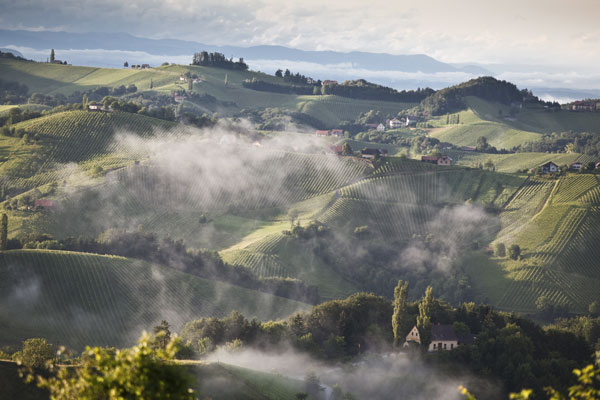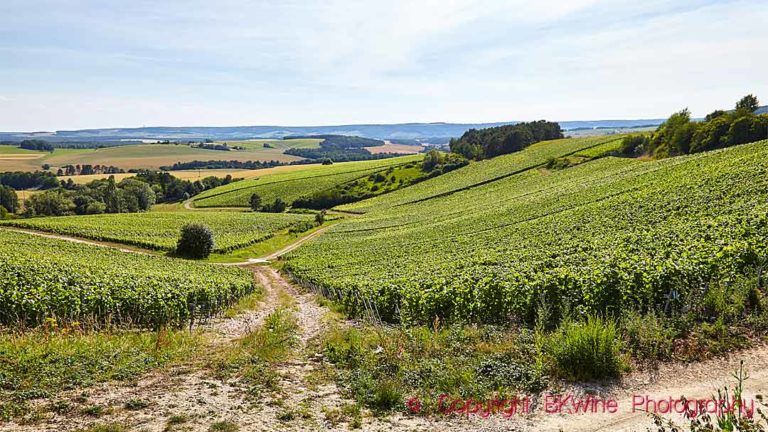Difficult year saved somewhat by nice autumn weather to give good quality but low quantity
It has been a difficult 2014 in Austria, as in many other parts of Europe. A poor summer, with sometimes very awful weather, has made life difficult for wine growers in Austria (as well as elsewhere in Europe). But also in Austria September came with nice weather that made it possible to harvest in good conditions. Willy Klinger, of the Austrian Wine Marketing Board, summarises the result like this: “Fortunately, our flagship grape variety, Grüner Veltliner, seems to have benefited from the favourable weather conditions that have been present since mid-September and promises surprisingly good quality. In summation, we are looking forward to beautiful wines with elegant fruitiness, although smaller quantities, especially in the Reserve category, can be expected.”
As always, the Austrian Wine Marketing Board supplies exemplary informative press releases so here is the full information that we have received from them. As Austrian wines are definitely worth discovering by more people we are happy to share this information with you in its entirety.

Austria’s Wine Harvest 2014 – A Year of Intense Work
Difficult weather conditions, persistent rainfalls and fewer sunshine hours demanded scrupulous care and extensive work in the vineyards from Austria’s winemakers this year, so that healthy and ripe grapes could be harvested. The wine grape volume will be once again below the long term average, but we can look forward to an Austrian 2014 vintage with fresh, very fruity and pleasantly drinkable wines.
Mother Nature’s weather performance this year was not exactly favourable to the Austrian winemakers. The optimistic forecast generated by a mild Winter and warm Spring were somewhat marred by low precipitation during the Winter and drought-like conditions until April.
Then came the rain. The wettest May since 1820 was also cooler than the long-term average. Nevertheless, the warmth at the beginning of the year and good weather during flowering provided a fine head start for the vegetation period. However, following a heat wave in early June, the Summer sun was not plentiful and there were high amounts of rainfall – all of which slowed up the earlier robust start to the vegetation period. Hopes for good harvest weather in September were dashed. The frequent rainfall increased the threat of rot and led to significantly more hours of work in the vineyard. It was necessary to check the health of the grapes constantly in order to make a good harvest selection. Accordingly, utmost attention and expertise were required also in the cellar. The result: a very fruity, fresh and easy-drinking vintage awaits us! The only downside is that the 2014 harvest, with an estimated 2.14 million hectolitres as of the end of October, is again well below the 10-year average.
Niederösterreich (Lower Austria)
Springtime was very warm, with the Weinviertel region in particular being marked by a persistent dry period. It took until May before the rains fell; then they did, everywhere, and twice as much as usual. Also during the hazy, overcast month of August, there was double the amount of rain and plenty of cloudiness. Even in September, there were no two consecutive days without rain. Not only did this hinder the progression of grape maturation, but it also led to susceptibility to grape rot, which made it necessary for several selections to be carried out in the vineyards in order to pick out the healthy grapes. Fortunately, at least the winemakers did not suffer from an invasion of the cherry fruit fly, which had caused severe damage in other European wine-producing countries. Finally, the weather improved, but only in October. In addition to the repeated grape selections, a difficult impact was made also by the lengthy period of the harvest. Even as of the end of October, wine growers were still waiting for higher gradations. The wines themselves are showing good balance despite all of the difficulties, as the moderate gradation increase led to a maturity-related reduction of total acidity in the grapes. This year’s slightly lighter wines, therefore, are already showing balanced acidity, which will require only minimal correction – if at all.
The moderate ripeness of the vintage is leading Grüner Veltliner to reveal its typical peppery character – which usually blends into the background at higher stages of ripeness in favour of tropical notes and spiciness. The Rieslings this year are, despite lighter alcohol, very harmonious – although still some full Reserve and Smaragd level Rieslings were harvested. The red wines are showing a fruity and understated character. Thus, the wines of Niederösterreich this year are fresh and fruit-forward, express typicity and pleasing drinkability.
Burgenland
The wine regions in Burgenland were largely unaffected by the drought-like conditions, but the flowering period was not optimal. The occurrence of coulure resulted in disappointing yield losses of between 25 and 40 percent. However, it proved to be an advantage during the extensive rains in the Fall, as the full and healthy grapes had enough room to hang on the bunches without pressing on each other, and thus avoided the inducement of rot. Still, thunderstorms and hailstorms also contributed to this year’s somewhat smaller harvest.
Zweigelt was harvested relatively early in many areas in order to bring more healthy grapes into the cellars. So this year, there were a higher number of harvesters in the vineyards to take quick advantage of the good weather phases. Compared to many other varieties, Blaufränkisch was particularly favoured this year because its grapes are late-maturing, loose and rather thick-skinned. Therefore, in Burgenland, especially in the Mittelburgenland and Eisenberg regions, Blaufränkisch was – albeit with a smaller amount expected – able to hang calmly on the vines and long into the season. In these regions, the harvest was slowly underway by the end of September, whereas in Seewinkel, it was already largely completed up to the Prädikat quality. Expectations for good gradations were met for the most part, and the upper quality levels were successfully achieved.
If the vinegar fly was a troublemaker this year, it caused no problem in Burgenland. For the Prädikat wines, all gradations up to Trockenbeerenauslese were harvested. But highly meticulous selections were necessary in order to bring only the beautiful botrytised grapes into the cellars.
The Burgenland wines of 2014 are marked by appealing fruitiness and easy drinkability. The lighter styles – also in the red wine range – will be very accessible, especially in their youth.
Steiermark (Styria)
Also in the southernmost wine region, a smaller-than-usual harvest volume – around 20 percent lower – is expected. The weather patterns were similar here, and provoked a two-to-three times higher workload under which the grapes had to be picked painstakingly in order to control the grape rot, which had spread like wildfire from the Südoststeiermark region.
Interestingly, the Welschriesling and Sauvignon Blanc varieties remained unaffected for the most part, while significant losses of Muskateller and Weissburgunder were recorded. A major hailstorm at the beginning of September in the Oststeiermark region was yet another addition to this year’s challenging weather history.
The Styrian wines this year are showing freshness and fruit-driven typicity. Particularly noteworthy is the good acidity structure that, together with the moderate alcohol levels, will provide an inspiring taste experience.
Wien (Vienna)
The vineyards of Vienna were exposed to weather patterns similar to those in the other wine regions. But there was one painful exception: A strong hailstorm on May 24th damaged up to 60 percent of the 180 vineyard hectares comprising the famous “three hills” – Nußberg, Reisenberg and Hungerberg. Otherwise, wineries in Vienna faced great challenges with the long harvest period and had to cope with the increased work load necessary for success in the vineyards and cellars.
From “Jungen Wiener” to the famous single vineyard wines as well as the Wiener Gemischten Satz, this year’s vintage is expected to yield fruity – though not opulent – wines marked with harmony and pleasurable drinkability.
Willi Klinger on the Austrian harvest conditions 2014:
“The cool and damp weather conditions during 2014 have required Austrian vintners to undertake the most scrupulous care in the vineyards with several selections necessary in order to get healthy and ripe grapes,” said Willi Klinger, general manager of the Austrian Wine Marketing Board. “Because of the highly demanding selection process, the harvest volume will be below average again. According to Statistik Austria, the volume has reached 2.14 million hectolitres. Fortunately, our flagship grape variety, Grüner Veltliner, seems to have benefited from the favourable weather conditions that have been present since mid-September and promises surprisingly good quality. In summation, we are looking forward to beautiful wines with elegant fruitiness, although smaller quantities, especially in the Reserve category, can be expected.”








